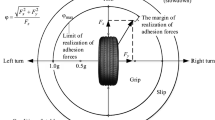Abstract
Since the invention of automobiles, the need to know the braking performance of vehicles has been acknowledged. However, because there are numerous design variables as well as nonlinearities in the braking system, it is difficult to predict the performance accurately. In this paper, a computational program is developed to estimate the braking performance numerically. This synthetic braking performance program accounts for pedal force, pedal travel and deceleration of braking parts, such as master cylinder, booster, valve, brake pad, rotor, and hoses. To improve the accuracy of program, a semi-empirical model of a braking system is introduced by using the empirical test data of pad compression, hose expansion and the friction coefficient between the pad and rotor. The accuracy of the estimation is evaluated by comparing it to the actual vehicle test results. The developed program is easy for the brake system engineers to manipulate and it can be used in the development of new vehicles by incorporating the graphical presentations.
Similar content being viewed by others
Abbreviations
- a :
-
deceleration
- A :
-
area
- BF :
-
brake factor
- C :
-
compression coefficient
- Cl Pad :
-
brake pad clearance
- D :
-
brake line diameter
- E:
-
Young’s modulus
- E P :
-
pedal effort
- K :
-
volume change constants
- l 0 :
-
non-effective stroke
- l P :
-
pedal ratio
- P :
-
pressure
- P 0 :
-
threshold pressure
- R t :
-
tire radius
- S p :
-
pedal stroke
- T :
-
temperature
- t :
-
thickness of brake hose
- ΣV i :
-
volume change
- W :
-
total weight
- F :
-
front wheel
- H :
-
brake hose
- l :
-
brake line
- MC :
-
master cylinder
- p :
-
brake pedal
- Pad :
-
brake pad
- r :
-
residual air in brake system
- R :
-
rear wheel
- system :
-
brake system
- WC :
-
wheel cylinder
References
Jack, E. and Robert, S. (1992). Automotive Technology. Delmar Publishers.
Jack, E. (2004). Automotive Brakes. NATEF.
Jung, S. P., Jun, K. J., Park, T. W. and Yoon, J. H. (2008). Development of the brake system design program for a vehicle. Int. J. Automotive Technology 9,1, 45–51.
Jung, I. H and Lee, S. H. (2004). Development of automotive braking performance analysis program considering dynamic characteristics. Trans. Korean Society of Automotive Engineers 12,2, 175–181.
Lee, C.-H. (2008). Development of a semi-empirical friction model in automotive drive shaft joints. Int. J. Automotive Technology 9,3, 317–322.
Limpert, R. (1992). Brake Design and Safety. SAE.
Author information
Authors and Affiliations
Corresponding author
Rights and permissions
About this article
Cite this article
Lee, C.H., Lee, J.M., Choi, M.S. et al. Development of a semi-empirical program for predicting the braking performance of a passenger vehicle. Int.J Automot. Technol. 12, 193–198 (2011). https://doi.org/10.1007/s12239-011-0023-y
Received:
Revised:
Published:
Issue Date:
DOI: https://doi.org/10.1007/s12239-011-0023-y




